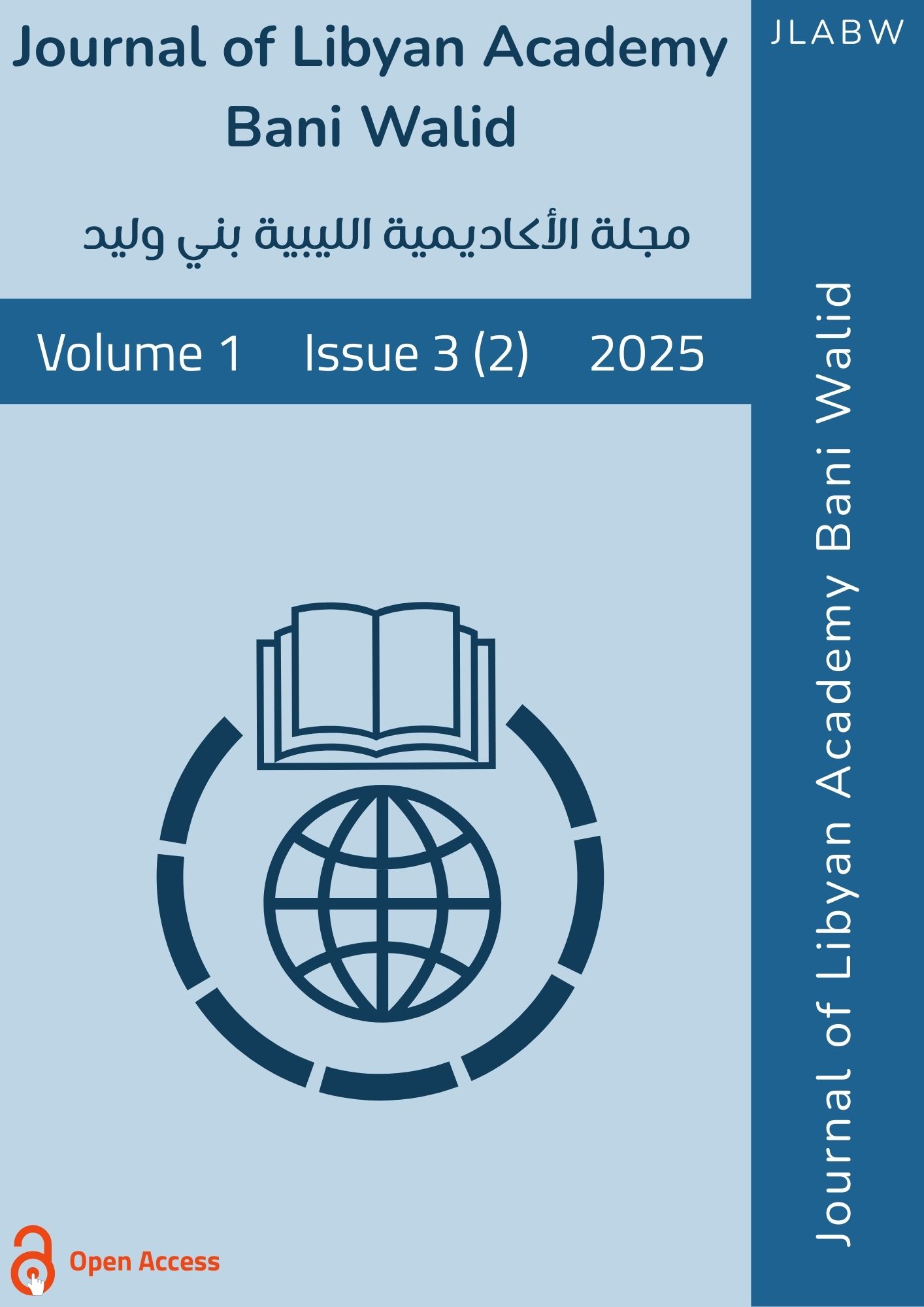Isolation and Identification of Bacteria Causing Urinary Tract Infections in Pregnant Women in Tarhuna city
DOI:
https://doi.org/10.61952/jlabw.v1i3.235Keywords:
Urinary tract infections, Pregnant women, Tarhuna, Bacterial isolation, Antibiotic resistance, Staphylococcus aureus, Escherichia coliAbstract
Abstract:
This study investigated the bacterial pathogens responsible for urinary tract infections (UTIs) among pregnant women in Tarhuna, Libya· A total of 72 urine samples were collected and analyzed using culture methods, biochemical tests, and MALDI-TOF confirmation where available· The findings revealed that Staphylococcus aureus was the most frequently isolated bacterium (45·5%), followed by Escherichia coli (20%), Klebsiella spp· (14·5%), and other pathogens such as Enterococcus spp·, Proteus spp·, and Streptococcus· The results showed that Nitrofurantoin and Ciprofloxacin were the most effective antibiotics, while high resistance rates were observed against Amoxicillin-Clavulanic acid and Trimethoprim-Sulfamethoxazole· These outcomes highlight the need for routine urine culture screening, targeted antibiotic stewardship, and continuous surveillance of antimicrobial resistance patterns· The study concludes that urinary tract infections remain a significant health problem during pregnancy, requiring proper diagnosis, treatment, and preventive strategies to minimize maternal and fetal complications.
References
• Abubakar, E. M. (2021). Bacterial pathogens associated with urinary tract infection among pregnant women in Maiduguri, Nigeria. Annals of Clinical Microbiology and Antimicrobials, 20, 32.
• Ahmad, S., et al. (2020). Rising prevalence of multidrug-resistant uropathogenic bacteria in pregnant women. Journal of Taibah University Medical Sciences, 16(1), 102–111.
• Ali, M. A., et al. (2024). Phenotypic and genotypic characterization of uropathogenic Escherichia coli isolated from pregnant women in Egypt. Microbial Pathogenesis, 183, 106144.
• Al-Khalidi, R. (2023). A review of urinary tract infections among pregnant women in Iraq: prevalence, risk factors, and antimicrobial resistance (2000–2023). Iraqi Journal of Medical Sciences.
• Al-Nasser, A., Mohammed, D., & Al-Ibrahim, W. (2021). Isolation and identification of bacterial strains from urine samples of pregnant women at Tishreen University Hospital. Tartous University Scientific Journal.
• Al-Taima, Z. (2024). Evaluation of the antibacterial effect of green nanocomposite on urinary tract infection bacteria in pregnant women [Master’s thesis, University of Karbala].
• El-Mahdi, A. (2019). Isolation and antimicrobial susceptibility of uropathogens among pregnant women at Benghazi Medical Center, Libya. Libyan Medical Journal.
• Flores-Mireles, A. L., Walker, J. N., Caparon, M., & Hultgren, S. J. (2015). Urinary tract infections: Epidemiology, mechanisms of infection and treatment options. Nature Reviews Microbiology, 13(5), 269–284.
• Ghahfarokhi, M. S., et al. (2023). Isolation and molecular detection of uropathogens in pregnant women: A comparative study of conventional and molecular methods. Journal of Infection and Public Health, 16(1), 88–95.
• McCormick, T., Ashe, R. G., & Kearney, P. M. (2008). Urinary tract infection in pregnancy. Obstetrics and Gynaecology, 10, 156–162.
• Mensah, P., et al. (2025). Risk factors and antimicrobial resistance of urinary tract infections in pregnant women in Ghana. African Journal of Reproductive Health.
• Mwaka, A. D., et al. (2021). Prevalence and antimicrobial susceptibility of bacterial uropathogens isolated from pregnant women with urinary tract infections in northern Uganda. Infection and Drug Resistance, 14, 1239–1247.
• Osman, H., et al. (2024). Bacterial profile and antibiotic susceptibility patterns of urinary tract infections among pregnant women in Sudan. Journal of Infection in Developing Countries, 18(3), 215–224.
• Salem, F. (2021). Prevalence and antimicrobial resistance of urinary tract infection pathogens among pregnant women in Eastern Libya. Eastern Mediterranean Health Journal.
• Shiblawi, K. K. (2022). Molecular detection of antibiotic resistance genes among bacteria causing urinary tract infections in pregnant women [Master’s thesis, University of Kufa].
• Tadesse, B. T., et al. (2020). Bacterial profile and drug susceptibility among urinary tract infection suspected pregnant women in Ethiopia: A cross-sectional study. BMC Infectious Diseases, 20, 613.
• Tadesse, W., et al. (2016). Asymptomatic bacteriuria and antimicrobial susceptibility among pregnant women in Ethiopia. BMC Pregnancy and Childbirth, 16, 99.
• Turay, A. A., & Emeka, M. (2022). Isolation and identification of uropathogens in pregnant women attending antenatal clinics in Lagos, Nigeria. African Journal of Clinical and Experimental Microbiology, 23(1), 24–31.
• UK Health Security Agency. (2023). Urinary tract infection (UTI). RCGP Learning.






